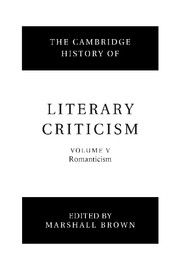Book contents
- Frontmatter
- Introduction
- 1 Classical standards in the period
- 2 Innovation and modernity
- 3 The French Revolution
- 4 Transcendental philosophy and Romantic criticism
- 5 Nature
- 6 Scientific models
- 7 Religion and literature
- 8 Language theory and the art of understanding
- 9 The transformation of rhetoric
- 10 Romantic irony
- 11 Theories of genre
- 12 Theory of the novel
- 13 The impact of Shakespeare
- 14 The vocation of criticism and the crisis of the republic of letters
- 15 Women, gender and literary criticism
- 16 Literary history and historicism
- 17 Literature and the other arts
- Bibliography
- Index
- References
17 - Literature and the other arts
Published online by Cambridge University Press: 28 March 2008
- Frontmatter
- Introduction
- 1 Classical standards in the period
- 2 Innovation and modernity
- 3 The French Revolution
- 4 Transcendental philosophy and Romantic criticism
- 5 Nature
- 6 Scientific models
- 7 Religion and literature
- 8 Language theory and the art of understanding
- 9 The transformation of rhetoric
- 10 Romantic irony
- 11 Theories of genre
- 12 Theory of the novel
- 13 The impact of Shakespeare
- 14 The vocation of criticism and the crisis of the republic of letters
- 15 Women, gender and literary criticism
- 16 Literary history and historicism
- 17 Literature and the other arts
- Bibliography
- Index
- References
Summary
I believe it may be considered as a general rule, that no Art can be engrafted with success on another art. For though they all profess the same origin, and to proceed from the same stock, yet each has its own peculiar modes both of imitating nature, and of deviating from it, each for the accomplishment of its own particular purpose. These deviations, more especially, will not bear transplantation to another soil.
It is a necessary and natural consequence of their perfection that, without any shifting of their objective boundaries, the different art forms are becoming increasingly similar to one another in their effect on the mind [Gemüt]. Music in its highest ennoblement must become form and move us with the quiet power of antiquity; plastic art in its highest perfection must become music and move us by means of its direct sensuous presence; poetry in its most perfect development must, like music, grip us powerfully but at the same time, like sculpture, surround us with quiet clarity. The perfect style belonging to each of the various art forms is shown in its ability to eliminate their specific limits without giving up their specific advantages.
Consider these statements written within ten years of one another. Each emanates from a figure who is at once a major theorist of art and a practitioner whose work retains its classical status today. Yet no two statements could be less alike in the circumstances under which they were voiced or in the roles we assign them within intellectual history.
- Type
- Chapter
- Information
- The Cambridge History of Literary Criticism , pp. 362 - 386Publisher: Cambridge University PressPrint publication year: 2000
References
- 3
- Cited by

